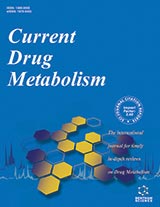摘要
Sphingosine-1-phosphate受体(S1PR)调节器已进入临床实践作为免疫调节剂治疗多发性硬化症(MS)。药理学的调制S1PR表情淋巴细胞抑制这些细胞能力应对S1P梯度区域内淋巴结(LNs)(胸腺)促进他们退出到末梢循环。结果外周血淋巴细胞减少限制被认为是构成S1PR调节器的能力,以减少新炎性病变形成女士在缺乏全球免疫抑制。这些调节器调节选择性进入淋巴细胞数量和树突状细胞(dc)LNs和调节sphingosine-1-phosphate(S1P)细胞信号网络管理特定细胞的生成在LNs子集。S1PR调节器,中枢神经系统也有功能的影响在这个舱由于S1PRs表达的细胞组成的血脑屏障(BBB)和那些在薄壁组织,包括神经元、星形细胞,胶质细胞和小胶质细胞。缺乏S1P1受体(S1PR1)星形胶质细胞可以降低实验性自身免疫性脑脊髓炎疾病严重程度(运算单元)。甚至抑制细胞反应条件下自然配体,S1PR调节器可以继续诱发积极信号响应;这样的反应可能是有关促进中枢神经系统内神经保护和增强组织修复。
关键词: FTY720. GPCR. 免疫调节剂. sphingosine-1-phosphate受体. 淋巴球减少症. 多发性硬化症.
图形摘要
Current Drug Targets
Title:Sphingosine-1-Phosphate Receptors in the Central Nervous and Immune Systems
Volume: 17 Issue: 16
Author(s): Luke M. Healy, Jack P. Antel
Affiliation:
关键词: FTY720. GPCR. 免疫调节剂. sphingosine-1-phosphate受体. 淋巴球减少症. 多发性硬化症.
摘要: Sphingosine-1-phosphate receptor (S1PR) modulators have entered clinical practice as immune-modulators for the treatment of multiple sclerosis (MS). Pharmacologic modulation of S1PR expression on lymphocytes inhibits these cells capacity to respond to the S1P gradient within regional lymph nodes (LNs) (and thymus) that promotes their exit into peripheral circulation. The resultant peripheral blood restricted lymphopenia is considered to underlie the capacity of S1PR modulators to reduce new inflammatory lesion formation in MS in the absence of global immune suppression. These modulators also regulate entry of selective lymphocyte populations and dendritic cells (DCs) into LNs and modulate sphingosine-1-phosphate (S1P) cell signaling networks that govern the generation of specific cell subsets within LNs. S1PR modulators that access the CNS can also have functional effects within this compartment since S1PRs are expressed by cells comprising the blood brain barrier (BBB) and by those within the parenchyma, including neurons, astrocytes, oligodendrocytes and microglia. Absence of S1P1 receptor (S1PR1) on astrocytes reduces disease severity in experimental autoimmune encephalomyelitis (EAE). Even under conditions that inhibit cell responses to the natural ligand, S1PR modulators can continue to induce active signaling responses; such responses may be relevant for promoting neuroprotection and augmenting tissue repair within the CNS.
Export Options
About this article
Cite this article as:
Luke M. Healy, Jack P. Antel , Sphingosine-1-Phosphate Receptors in the Central Nervous and Immune Systems, Current Drug Targets 2016; 17 (16) . https://dx.doi.org/10.2174/1389450116666151001112710
| DOI https://dx.doi.org/10.2174/1389450116666151001112710 |
Print ISSN 1389-4501 |
| Publisher Name Bentham Science Publisher |
Online ISSN 1873-5592 |
 117
117 12
12 1
1 1
1
- Author Guidelines
- Graphical Abstracts
- Fabricating and Stating False Information
- Research Misconduct
- Post Publication Discussions and Corrections
- Publishing Ethics and Rectitude
- Increase Visibility of Your Article
- Archiving Policies
- Peer Review Workflow
- Order Your Article Before Print
- Promote Your Article
- Manuscript Transfer Facility
- Editorial Policies
- Allegations from Whistleblowers
Related Articles
-
Use of Kv1.3 Blockers for Inflammatory Skin Conditions
Current Medicinal Chemistry Cell Adhesion Molecules as Pharmaceutical Target in Atherosclerosis
Mini-Reviews in Medicinal Chemistry Extracellular Vesicles as Innovative Tools for Assessing Adverse Effects of Immunosuppressant Drugs
Current Medicinal Chemistry Traumatic Spinal Cord Injury Alters Angiogenic Factors and TGF-Beta1 that may Affect Vascular Recovery
Current Neurovascular Research Anti-Inflammatory Properties of Drugs from saffron crocus
Anti-Inflammatory & Anti-Allergy Agents in Medicinal Chemistry Mesenchymal stem cell therapy for inflammatory bowel diseases: promise and challenge
Current Stem Cell Research & Therapy Evaluation of Venom as a Promising Tool for Drug Discovery: Focusing on Neurological Disorders
Venoms and Toxins Interleukin-10
Anti-Inflammatory & Anti-Allergy Agents in Medicinal Chemistry The Role of microRNA in Ischemic and Hemorrhagic Stroke
Current Drug Delivery Targeting the Voltage-Dependent K+ Channels Kv1.3 and Kv1.5 as Tumor Biomarkers for Cancer Detection and Prevention
Current Medicinal Chemistry Therapeutic Peptide Mimetics Looking for a Turn to Block Aberrant Players of Malignancy
Current Cancer Therapy Reviews Oxidative and Nitrosative Stress and Immune-inflammatory Pathways in Patients with Myalgic Encephalomyelitis (ME)/Chronic Fatigue Syndrome (CFS)
Current Neuropharmacology The IL23/Th17 Pathway as a Therapeutic Target in Chronic Inflammatory Diseases
Inflammation & Allergy - Drug Targets (Discontinued) The AKT Axis as a Therapeutic Target in Autoimmune Diseases
Endocrine, Metabolic & Immune Disorders - Drug Targets Gene Therapy-Mediated Modulation of Immune Processes in the Central Nervous System
Current Pharmaceutical Design Gastrointestinal Immune System and Brain Dialogue Implicated in Neuroinflammatory and Neurodegenerative Diseases
Current Molecular Medicine Distribution of Podoplanin in Synovial Tissues in Rheumatoid Arthritis Patients Using Biologic or Conventional Disease-Modifying Anti-Rheumatic Drugs
Current Rheumatology Reviews The Role of Natural Killer T Cells in Atherosclerosis
Current Immunology Reviews (Discontinued) Functional Interactions Between B Lymphocytes and the Innate Immune System
Infectious Disorders - Drug Targets Xenobiotic and Non-Xenobiotic Interventions in the Microbiome Therapeutics
Current Drug Metabolism


























